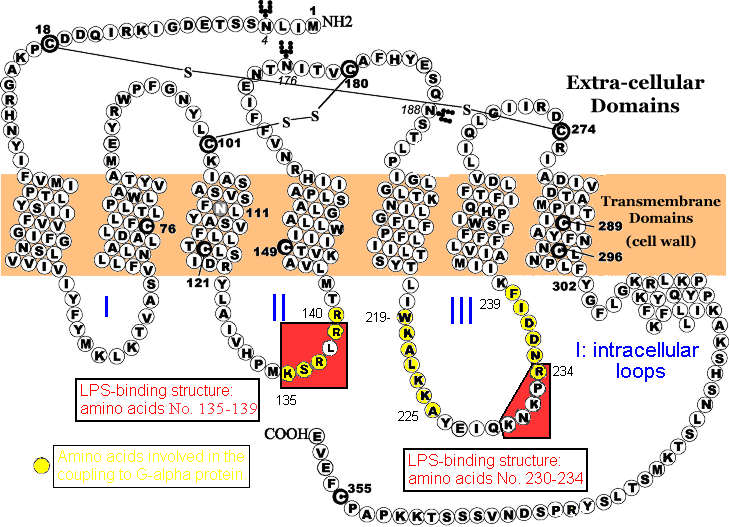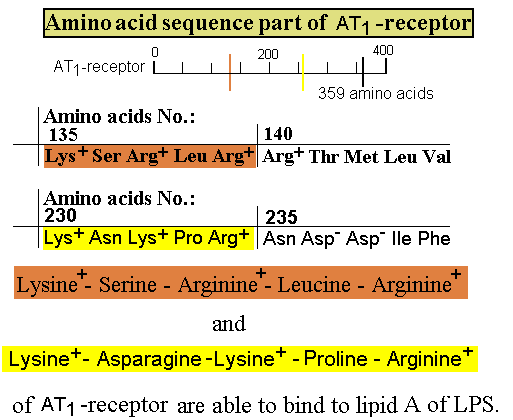
Human Angiotensin III as treatment of Lipopolysaccharide-induced Polyneuropathy and Parkinsonism
Ines Niehaus
Comments to:
Ines_Niehaus@gmx.de

Structure of human Angiotensin III:
Angiotensin III (molecular weight of 884.9782 g/mol) formed in vivo from Angiotensin II after the removal of Asp at the N-terminal by Aminopeptidase A is a heptapeptide with the amino acid sequence of Arg1-Val2-Tyr3-Ile4-His5-Pro6-Phe7.
The first five amino acids (Arg1-His5) of the heptapeptide contain the probably LPS-binding amino acid sequence similar to the pattern of B-H-P-H-B (Arg+, hydrophobic, polar, hydrophobic,His+).
The octapeptide Angiotensin II with the sequence of Asp–1Arg2-Val3-Tyr4-Ile5-His6-Pro7-Phe8
would perhaps weakened or even prevent the LPS-binding (LPS-binding sequence:
Arg2-His6) by neutralization of the positively charged arginine
Arg2 by the negatively charged Asp1.
Angiotensin II Type 1 receptor:
The Angiotensin II Type 1 receptor (AT1-receptor) contains two LPS-binding
pentapeptide sequences, which binding
to lipid A of LPS might prevent the intracellularely coupling to G-alpha-protein of the (AT1-receptor)
with loss of the signal transfer after binding of the ligand angiotensin II or angiotensin III.


Angiotensin II Type 2 Receptor:
The Angiotensin II Type 2 receptor (AT2-receptor) does not contain a LPS-binding sequence.
This is the first case report describing a treatment with human angiotensin III for an up to now 15 years long-lasting persistent endotoxemia causing chronically systemic and neuronal inflammation with septic polyneuropathy, encephalopathy and parkinsonism after one single accidental contamination with 10 µg highly purified Salmonella minnesota S-LPS in 1995.
More Information to the case report on:
www.s-lps.de/sepsis.html
Treatment with Human Angiotensin III:
The first oral dose of 0.1 mg (= 0.113 micromol) angiotensin III was taken on December, 4th 2009.
Angiotensin III caused no increase of blood pressure at any time but an improved blood flow
remarkable by an inner warming of foot and hands 15 min after taking the first dose.
One hour later
increased blood flow of inner organs occured and a general muscle relaxing effect.
After several hours the heart frequence was slowered to a physiological heart beat
of 60 to 65 beats/min in rest. Before that, the patient suffered from
tachykardia for 15 yrs with pulse frequences of 75 to 95 in rest.
Several spots of blood vessels had a longer period of warming with very little paining
starting two hours after taken angiotensin III. The largest spot was located in the lower
part of the left leg.
The general improved blood was accompanied by an improvement of vision, hearing and even
fine motor skills.
In the night after the first oral dose of angiotensin III tickling sensations of the left body
side especially of the left leg occured. The morning after an extremely improved walking
and bicyling ability of the left leg with reoccuring of for years missing muscle power occured.
These positive effects are still permanent independent upon taken of new doses of angiotensin III.
LPS might be able to block the effects of angiotensin II and angiotensin III by:
1. Direct binding to the amino acids Arg1-His5 of the heptapeptide angiotensin III
2. Binding to the second and third intracellular loop of the AT1-receptor with
blocking of the binding to G-alpha proteins with loss of intracellular signal transfer.
Lipid A of LPS binds to the amino acid sequences of lys+-ser-arg+-leu-arg+ (amino acid No. 135-139 of the second
intracellular loop of the AT1-receptor) and of lys+-asn-lys+-pro-arg+ (amino acid No. 230-234 of the
third intracellular loop of the AT1-receptor)(see Fig. 3).
The ineffeciacy of angiotensin III blocked by direct binding to LPS and the LPS blocked AT1-receptor
might be two reasons for the fall of blood pressure in septic shock.
How is orally administered human angiotensin III effective in the treatment of LPS-induced septic polyneuropathy and parkinsonism?
LPS-blocked AT1-receptors might downregulate preproenkephalin mRNA
expression with reduced angiotensin levels or physiological angiotensin III might be blocked
by binding to LPS. The uptaken angiotensin III is most effective in stimulation
of AT2-receptors because this receptor is not blocked by LPS intracellularely.
The missing increase of blood pressure by the treatment of angiotensin III could be explained
by the lack of AT1-receptor stimulatory effect.
Stimulation of AT1-receptors and AT2-receptors increase the firing rate
of neurons but the stimulatory effect of AT2-receptor is more effective.4
Angiotensin II stimulates the functional recovery of the rat lesioned sciatic nerve in vivo.
3
A concentration of 10-11mol/l angiotensin II is highly neuroregenerative,
where as a higher concentraion of 10-10 mol/l is less neurotrophic.
A concentration of 10-7mol/l has an opposite effect on neuroregeneration
in this animal model.
3
Other neuroprotective peptides are for e. g. the tripeptide gly-gly-phe and the
pentapeptide leucine enkephalin (tyr-gly-gly-phy-leu). 5
Conclusions: This is the first case report reporting about an effective treatment of septic polyneuropathy and parkinsonism with µmol oral doses of human angiotensin III.
References:
1) Frecer V, Ho B, Ding JL.
Interpretation
of biological activity data of bacterial endotoxins by simple
molecular models of mechanism of action.
Eur J Biochem. 2000; 267(3):837-52.
2) Conchon S, Barrault MB, Miserey S, Corvol P, Clauser E.
The C-terminal third intracellular loop of the rat AT1A angiotensin
receptor plays a key role in G protein coupling specificity and transduction
of the mitogenic signal.
J Biol Chem. 1997; 272(41):25566-72.
3) Reinecke K, Lucius R, Reinecke A, Rickert U, Herdegen T, Unger T.
Angiotensin II accelerates functional recovery in the rat sciatic nerve in vivo:
role of the AT2 receptor and the transcription factor NF-kappaB.
FASEB J. 2003; 17(14):2094-6.
4) Harding JW, Felix D.
Angiotensin-sensitive neurons in the rat paraventricular nucleus:
relative potencies of angiotensin II and angiotensin III
Brain Res. 1987; 410(1):130-134
5) Qin L, Liu Y, Qian X, Hong JS, Block ML.
Microglial NADPH oxidase is a novel target for femtomolar
neuroprotection against
oxidative stress.
Ann N Y Acad Sci. 2005; 1053: 107-20
6) Streck EL, Comim CM, Barichello T, Quevedo J.
The septic brain.
Neurochem. Res. 2008; 33(11):2171-7
7) Marshall TG, Fenter B, Marshall FE.
Putative Antibacterial Mechanisms for Angiotensin II
Receptor Blockers.
JOIMR 2004; 2(2):1
e-mail: Ines_Niehaus@gmx.de
This website was published on February, 2nd 2010.
Last update: September, 24th 2010.